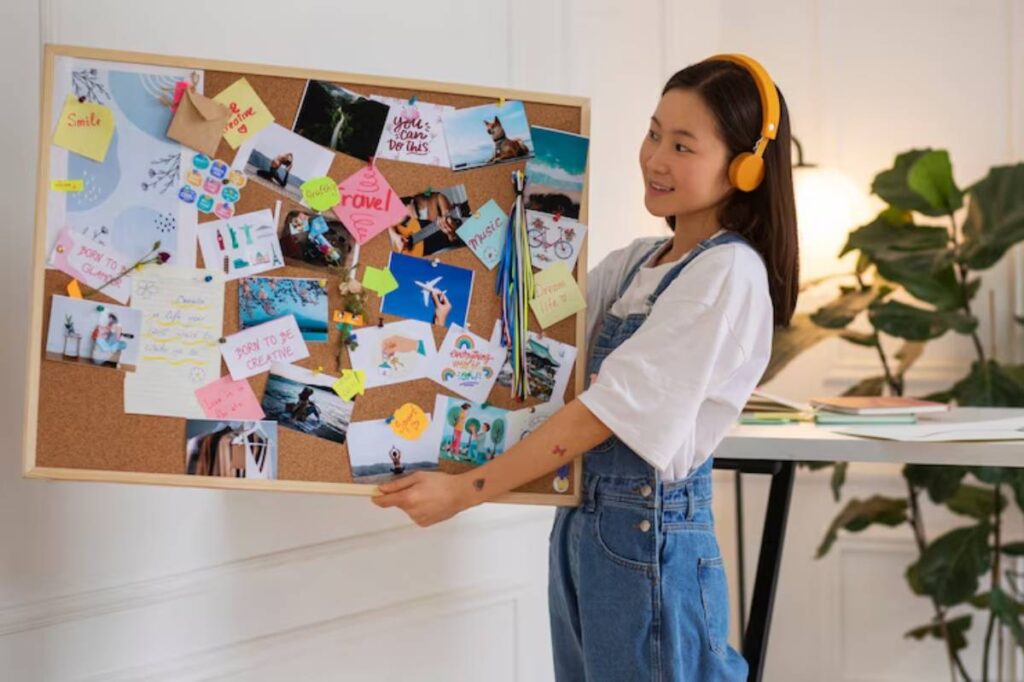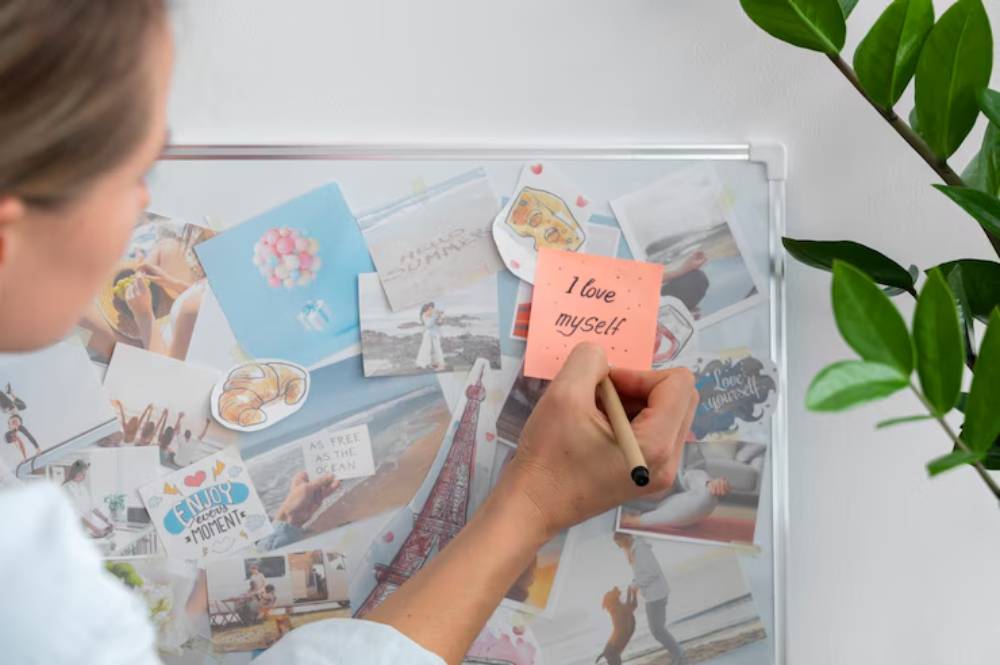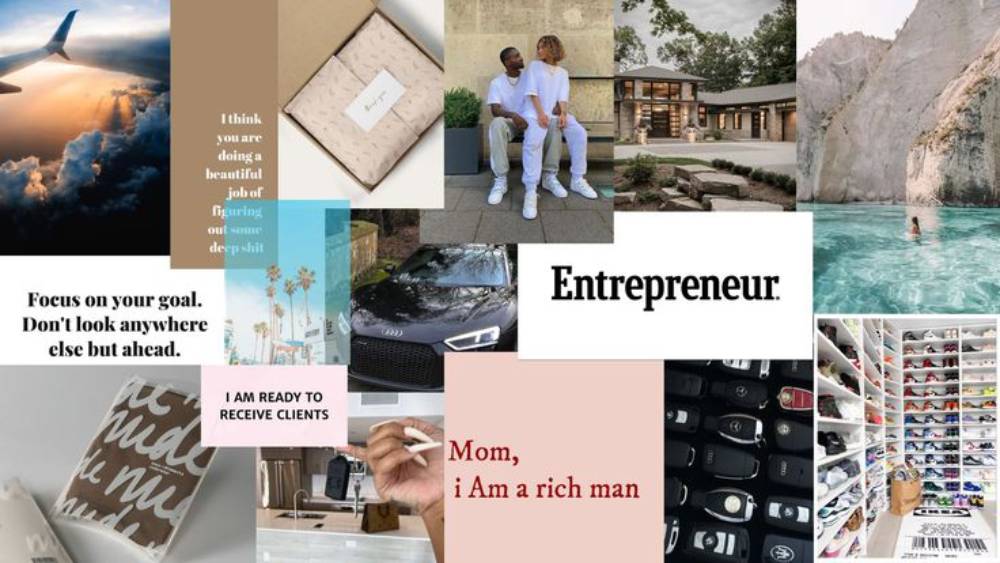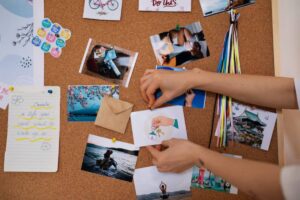The Personal Development Blog

Creative Personality Vision Boards: Going Beyond the Norm
Vision boards are often portrayed as tidy, well-arranged collages with magazine cutouts and neatly printed quotes. But not everyone dreams in straight lines and colour-coded boxes. For some, clarity arrives through chaos. Meaning flows from movement. If that sounds familiar, welcome. This is for the dreamers who doodle in margins, who feel more than they explain, who live in the layered language of creativity.
Artistic vision boards aren’t just about goals—they’re about feeling them, experiencing them, and letting the process of creation be as valuable as the result. Let’s explore how creative mind goals translate into abstract visualisation, and how to build a board that’s as expressive as the person behind it.
The Creative Personality: What Makes It Unique?
Creative personalities see the world through metaphors, moods, symbols, and sensations. While others chase metrics and timelines, creatives chase flow, inspiration, and alignment. And that doesn’t mean goals are any less important—just that the route there might be a little less predictable, a little more…wild.
It’s not just about what’s on the board. It’s how it’s made. The freedom. The layering. The blending of ideas and instinct. The energy it radiates when it’s done.
So let’s set the structure aside (just for a moment) and step into a visioning process that invites you to play.
Vision Boards for Creative Thinkers: Why They Matter
Sometimes, creative folks struggle with traditional goal-setting because it feels too rigid or surface-level. A typical SMART goal might feel like a cage rather than a map. That’s where artistic vision boards come in.
They allow space to:
- Express emotion before structure
- Represent possibility through texture and colour
- Set intentions without pinning them down too tightly
- Explore identity as much as achievement
Because creative goals aren’t just about what gets done. They’re about who you become in the process.
Abstract Visualisation: The Language of the Creative Subconscious
Traditional vision boards often rely on literal imagery—photos of dream houses, perfect beach bodies, six-figure paychecks. But what if your vision is more about a feeling than a fixed image?
That’s where abstract visualisation becomes powerful.
Consider:
- A swirl of watercolour that represents freedom
- A scrap of gold leaf to symbolise abundance
- A torn map showing a winding path as a metaphor for trust in the journey
These abstract symbols might not make sense to anyone else—and they don’t have to. They speak directly to your creative subconscious, where change begins long before it shows up on a checklist.
Want help laying out your goals in the most effective structure? Check out Best Vision Board Layouts for Maximum Clarity to explore more strategies.
Elements to Include in an Artistic Vision Board
Let go of the “rules.” Instead, ask what medium calls to you. Paint? Collage? Ink? Fabric? Mixed media?
Here are components that work beautifully on expressive boards:
1. Textures
Velvet, sandpaper, lace, mesh—what textures mirror your dreams? A soft cloth might represent ease. A rough edge might reflect resilience.
2. Symbols and Metaphors
Birds for flight. Waves for change. Keys for opportunity. Use visual poetry to express your dreams without spelling them out.
3. Handwritten Words

Forget typed fonts. Let your handwriting, even messy or crooked, carry your voice. A scribbled phrase can hold more energy than a perfect quote.
4. Colour Moods
Colour is a language. Think beyond pretty combinations—choose hues that reflect your emotional palette. Soft blue for calm. Orange for expansion. Deep green for grounding.
5. Movement
Add string, arrows, or flow lines to guide the eye. Motion mirrors momentum. The more dynamic your board, the more alive it feels.
Creative Mind Goals: How to Set Them Without Losing the Magic
Goal-setting often intimidates creative minds because it feels restrictive. The trick is to anchor the intention, but leave room for improvisation.
Instead of “publish a novel by December,” try:
- “Nurture my storytelling voice”
- “Devote two hours a week to writing that excites me”
- “Explore new ways to share my words”
Then translate those themes visually—images of typewriters, forests, ink-stained hands, blank notebooks, open skies.
Your board becomes less of a demand and more of a dialogue.
Tips for the Creative Visioning Process
1. Start With a Feeling, Not a Goal
Before grabbing scissors or supplies, close your eyes. Ask: What do I want to feel this year? Safe? Energized? Wildly alive?
Let those emotions lead the visuals.
2. Collect Intuitively
Don’t overthink. Tear out pages, sketch shapes, splatter paint. Let it be raw. Let it be real.
3. Layer Slowly
Add to your board over days or weeks. It’s a living document. Let it shift as you shift.
4. Play With Shape
Who says a vision board has to be a rectangle? Use a circle. A spiral. A series of overlapping frames. Make it move like your mind.
Digital Vision Boards for Creatives

Yes, you can still be creative digitally. If glue and scissors aren’t your thing, try:
- Pinterest Boards: Curate moodboards by theme
- Procreate or Canva: Mix hand-drawn elements with text and photos
- Notion Dashboards: Embed images and links into flexible planning pages
- Screensavers: Design an artistic desktop or phone background with visual cues
The key is to break from the grid. Use layering, collage, unexpected overlaps. Let your digital space breathe and bloom.
Keeping It Alive: How to Engage With Your Board Creatively
This isn’t something to glue down and forget.
Keep the creative pulse going by:
- Journaling about one image a week
- Playing music that matches the board’s energy
- Using it as a backdrop for meditation or brainstorming
- Adding new pieces as new ideas arrive
- Changing it seasonally to reflect your evolving mood
When to Use Abstract Visualisation Over Literal Planning
Use abstract approaches when:
- You’re feeling stuck with traditional planning
- You don’t know exactly what you want, but you know how you want to feel
- You’re craving beauty and flow, not boxes and deadlines
- You’re exploring a new identity or phase in life
Let the board be a mirror of your becoming, not just a reminder of what needs doing.
Mistakes Creative Types Often Make—And How to Fix Them
1. Making It Too Pretty
Perfection can become a prison. Let it be messy, textured, and alive.
2. Trying to Explain Everything
Don’t. This is for your soul, not your peers. Let some symbols remain mysterious.
3. Never Finishing
Give yourself a deadline—but not a hard one. Aim for “done enough to inspire” rather than complete.
4. Forgetting to Revisit It
Keep it where your eyes wander—above your desk, behind the bathroom door, beside your coffee station.
Need help identifying which dreams belong where? Breaking Down Life Areas for Vision Board Planning is a useful read.
Vision Boards As Creative Practice
There’s no single right way to envision the future. But for creative minds, the board becomes more than a plan. It becomes an expression. An artwork. A ritual. A declaration.
So skip the templates. Ignore the rules. Use paint, poetry, feathers, thread. Let it sing, whisper, expand. Let it confuse you, surprise you, speak back.
Because the real power of artistic vision boards lies not just in the goals they represent, but in the permission they give—to imagine, to explore, and to build a future as vibrant and unique as the soul dreaming it.
Let the vision rise from the canvas—not just as a map, but as a masterpiece.









